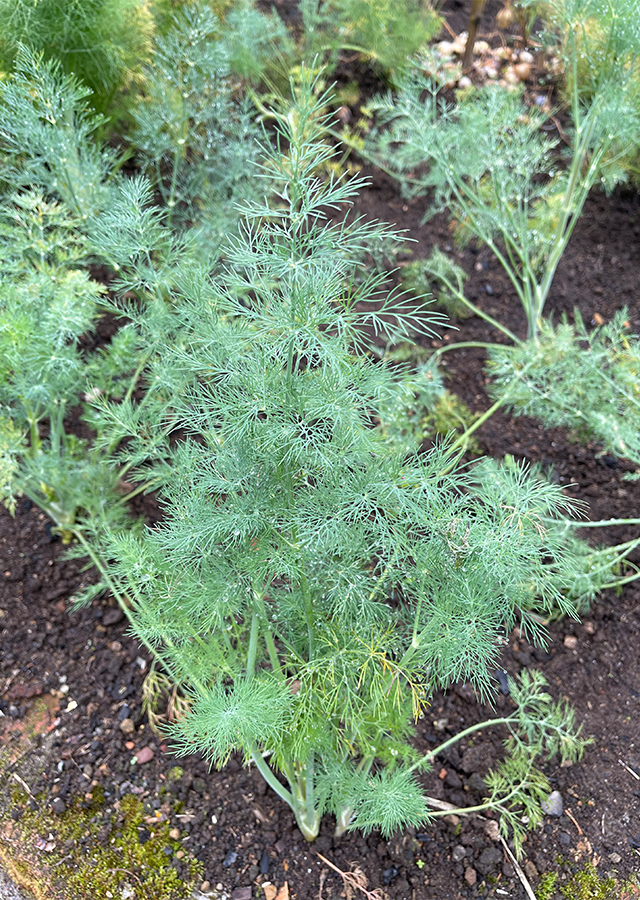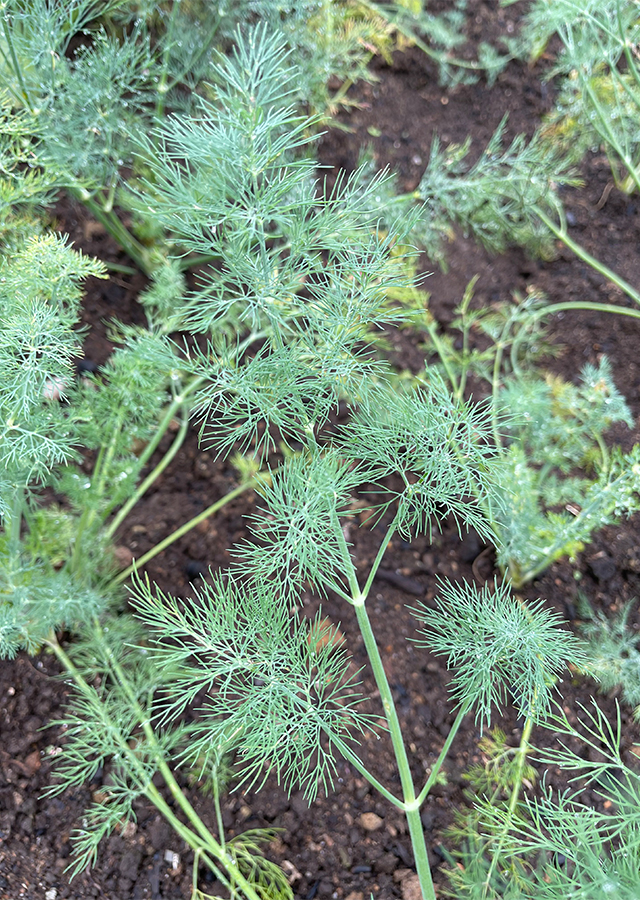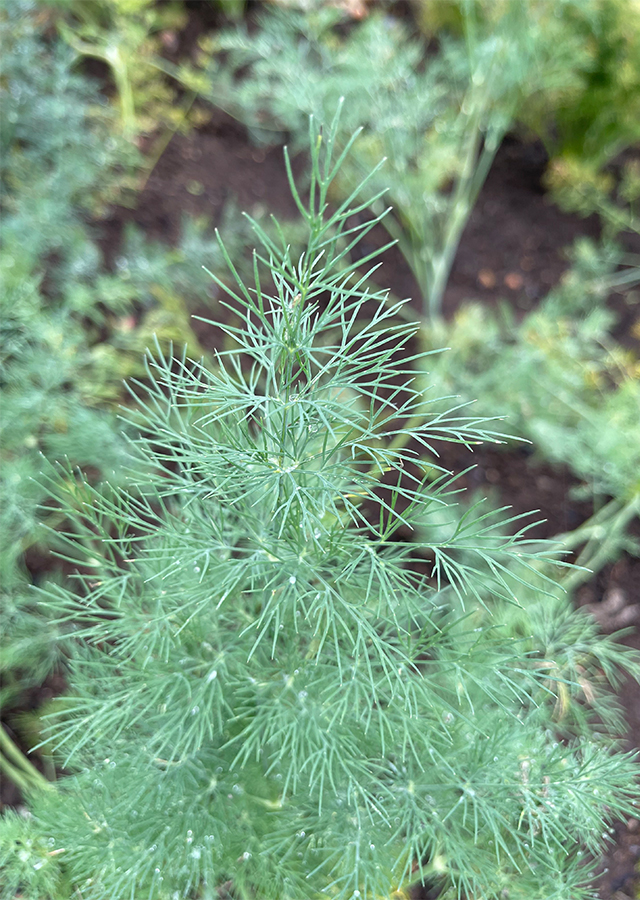Garden Dill
Anethum graveolens L.
Apiaceae
Location in our garden
Principal



Synonym
Anethum arvense Salisb
Anethum sowa Roxb. ex Fleming
Angelica graveolen (L.) Steud
Habitus
Herbaceous. Erect, annual, blue-green, glabrous herb with aromatic foliage and seeds growing up to 90 cm in height
Part Used
Leaves
Seeds
Growing Requirements
Full Sunshine
Habitat
Terrestrial
Overview
The plant may have originated in Eurasia, perhaps southern Asia, but it is now known around the world, especially across Europe and the Americas. It has been cultivated for centuries, having been known for its culinary use by the ancient Egyptians and, later, Romans. Now it is cultivated, usually in home gardens, all over the world, including South-East Asia.
Vernacular Names
Adas china (Malay), Thian-khaopluak (Thai), Thià là (Vietnamese), Samin (Burmese), Phak s'i (Laos), Shi luo (Chinese), Aneth odorant (French), Anis aleman (Spanish), Sowa (India), Aneto odoroso (Italian), Bisbas (Arabic), Gurkenkraut (German)
Agroecology
In the tropics this plant can successfully be grown up to altitudes of 2000 m. The annual rainfall or water requirement (irrigation) ranges from 500-1700 mm. It does not tolerate wet conditions or frost and thrives in full light at monthly average temperatures of 16-18 °C. Minimum temperature for growth is about 7 °C. It prefers a sandy loam soil with pH 5.6-6.5.
Morphology
- Roots - taproot up to 12 mm in diameter.
- Stems - subterete, up to 12 mm in diameter, very branched, sulcate, internodes often hollow.
- Leaves - alternate, decompound, sheathed; sheath forming an open cone, embracing the stem at base, 1-3(-5) cm long, sulcate; petiole subterete, equally long or up to 13 cm longer than the sheath, lower leaves usually rather long petiolate, higher ones almost without petiole, blade triangular to ovate in outline, up to 30 cm × 50 cm, usually much smaller, pinnately divided into 2-6 pairs.
- Flowers - bisexual, actinomorphic, some central ones often remaining rudimentary, protandrous, calyx vestigial, sometimes 5 small teeth present on top of ovary; petals 5, distinct, subovate in outline, top strongly inflexed and notched, yellow; stamens 5.
- Fruits - a lens-shaped schizocarp, 2.5-6 mm × 2-4 mm, light or dark brown with a whitish to pale brown margin, splitting at maturity into 2 one-seeded mericarps which are attached at their top to an erect thin carpophore.
- Seeds - hypocotyl 5-25 mm long; cotyledons opposite, linear, 15-50 mm × 1-2 mm, entire.
Cultivation
Propagated by seeds - Seeds are sown directly in the field (which should have been thoroughly cultivated and be weed-free) at a depth of 3-6 mm. The sowing rate is 5-7 kg seed per ha. Germination occurs in about 1-3 weeks (faster at higher temperature). When grown for seed, optimum row and plant spacings are 45 cm and 10 cm respectively. Dill grown for the herb is sown at higher densities. Mostly, however, dill grown as a garden crop is intercropped, e.g. between onions, parsley or carrots.
Chemical Constituents
Tannins, terpenoids, saponins, steroid, flavonoid, cardiac glycosides, anthraquinone, ascorbic acid, phellandrene, epoxy-p-menth-1-ene, carvone, limonene, diterpene, cineole, myrcene, myristin, apiol.
Traditional Medicinal Uses
- Studies have suggest antibacterial, antioxidant, hepatoprotective, hypolipidemic, antifungal, antispasmodic, antiulcer, antisecretory, repellent, antimycobacterial, hypoglycemic, anti-inflammatory, hematopoietic, anticonvulsant properties.
- Infusion of the seed used for insomnia. Infusion also used for stomach acidity, flatulence, dyspepsia, colic.
- The seed boiled in olive oil and applied warm over furuncles hastens suppuration and provides pain relief.
- Chewing of the seeds helpful in halitosis.
- Nursing mothers use the dill to increase milk flow.
- Decoction of the herb used for colic in babies. Seed decoctions are more potent and should be adjusted accordingly.
Part Used
Reference Sources
- Stuartxchange. 2021. Philippine Medicinal Plants: Dill. http://www.stuartxchange.org/Dill. 21-09-2021.
- CAB International. 2021. Anethum graveolens (dill). https://www.cabi.org/isc/datasheet/3472. 21-09-2021.
- Plant Resources of South-East Asia. 2016. Anethum graveolens (PROSEA). https://uses.plantnet-project.org/en/Anethum_graveolens_(PROSEA). 21-09-2021.


